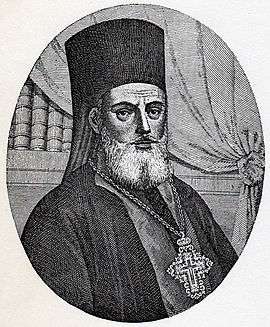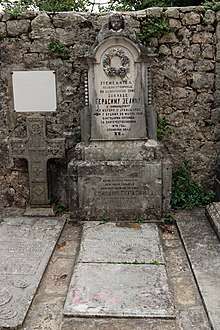Gerasim Zelić
Gerasim Zelić (Serbian: Герасим Зелић; 1752–1828) was a Serbian Orthodox Church archimandrite, traveller and writer. His chief work is Žitije (Lives), in three volumes.[1] They are memoirs of his travels throughout western Europe, Russia and Asia Minor from the latter half of the 18th century to the first decade of the 19th century and the famous personalities (Napoleon, Eugène de Beauharnais, Viceroy of Italy, Joseph II, Holy Roman Emperor, Leopold II, Holy Roman Emperor, Francis II, Holy Roman Emperor, Semyon Zorich, Catherine the Great, Alexander I of Russia, Stanisław August Poniatowski, Dositej Obradović) he encountered. He left behind invaluable original notes on the people, religions, manners, customs, and trade of his era.
Gerasim Zelić Герасим Зелић | |
|---|---|
 | |
| Born | 11 June 1752 Žegar, Bukovica, Habsburg Empire (modern Obrovac, Croatia) |
| Died | 26 March 1828 Budapest, Hungary |
| Resting place | Krupa monastery |
As much as Dositej Obradović is an emblematic figure of the 18th century Habsburg Serbian Enlightenment so is Gerasim Zelić. In many ways the East-West travel itineraries of the two men are similar, covering the Levant, the German lands, France and Russia, though Zelić went first to Russia (rather than to the Levant). While both lament their people's plight under the Ottoman rule and promote similar solutions, their perspectives are different, Dositej's cosmopolitanism contrasting with Zelić's clericalism, though their intentions are the same: the emancipation of their people from under the tyrannical yoke of the two empires, the Habsburg and the Ottoman.
Zelić was one of the earliest members of the Serbian Learned Society, better known as Matica srpska, founded at Budapest in 1826.
Biography
Gerasim Zelić was born on 11 June 1752 in Žegar, Bukovica, in northern Dalmatia, some 30 miles east of Zadar, then part of the Habsburg Monarchy. He owed his monastic name (Gerasim) to a vow which his mother, driven by the graveness of her son's illness, had made: to dedicate him to the Krupa Monastery should he survive. He did survive and his mother's vow was fulfilled. He was tonsured with ordination by a bishop in 1769 at the age of 17. His literary education was rather desultory, as he intended to be an artist, as some of his predecessors. But the quaint existence in the monastery did not appeal to him and after being entrusted with a complex mission he was allowed by his abbot to leave the monastery in 1782 and set out to learn icon-painting elsewhere. He initially intended to go to Corfu but some last-minute advice received in Venice made him change his mind and, avoiding the imprisonment which usually awaited those who announced within the Republic of Venice their desire of going to Imperial Russia, he successfully reached Kiev and spent the next half-year in the Kiev Pechersk Lavra learning icon-painting until a problem arose. His weak eyesight put an end to those career ambitions, so he studied at the Kiev Mohyla Academy, intending to devote himself to educating the illiterate, however, destiny had other plans for him.
Zelić was present in the Crimean Khanate and witnessed the Tartar surrender when Russia annexed the entire peninsula on 8 April 1783. In August of that year he was in Kherson where his passport was extended by none other than the great Potemkin himself. After spending a few months in Imperial Russia, visiting Serbian expatriates, including General Semyon Zorich in Shkloŭ, Zelić set out on his homeward journey with a good supply of books. When he reached Constantinople he decided to visit our holy Mount Athos, and Hilandar monastery in particular. There the mockery and name-calling of the Greek monks angered him to such a point that in his intervals of leisure he mastered Greek in five months. On his return to Constantinople, he was promoted to archimandrite by the Patriarch of Jerusalem, but when he got back to Krupa Monastery the jealous monks refused to recognize his promotion. In dissatisfaction, he set out again to Imperial Russia. En route he was presented to King Stanislaus II in Warsaw and in Kiev he met Empress Catherine the Great and Emperor Joseph and King Stanislaus II again.
He arrived in St. Peterburg on 24 March 1787, the Wednesday of Holy Week and quickly made himself known to Metropolitan Gabriel. He was chosen to read the Gospel in Greek at the Easter Service, an honour bestowed on very few foreigners. He was also well received in the highest circles in St. Petersburg and was impressed by the hospitality accorded to foreign prelates. The members of the Holy Synod of the Russian Orthodox Church, however, were distrustful because, as he later learned from the Metropolitan, a detractor had sent a false report to the Synod stating that Zelić was not an archimandrite and did not have a monastery in Dalmatia. So he was not given permission to collect alms in Russia. However, private people treated him with the utmost respect and infinite generosity and when he left St. Petersburg on 20 May 1787, a month and a half after his arrival, it was with a carriage which had been given to him, and with gifts of money, cloth of gold, church vessels, a large cross, dinner and coffee service for twelve persons, two English watches, one gold and one silver, and many liturgical and instructive books. He then went to Elizavetgrad to ask Potemkin for a passport and stayed about a month with him before leaving for Dalmatia.

In 1792 the Venetian Government accorded him the title of Vicar-General of Dalmatia and as Vicar General and Archimandrite he made an episcopal visitation and carried out many reforms in church and social life. He was confirmed in office by the Austrians in 1797 but in 1806 the French, then rulers of Dalmatia, distrusted his loyalties and detained him in Zadar. However, he was released after a while, and in 1808 he was permitted to go to Milan to request of the Viceroy Prince Eugène, to plead with Napoleon that the appointments of Orthodox bishops in Dalmatia be allowed – something which Venice had refused to permit. Napoleon soon granted this request and in 1810 Zelić was in Paris on an ecclesiastical deputation to him to this effect. During the stay of the deputation, Napoleon tricked Zelić by appointing a somewhat mysterious and shady figure by the name of Benedikt Kraljević as Bishop of Dalmatia and Zelić himself as Kraljević's subordinate, Vicar Bishop of Boka Kotorska. Napoleon's navy had previously tried to take Boka Kotorska but was repelled by the overwhelming presence of the British and Russian fleets ensconced there. Soon Zelić and Kraljević parted ways and towards the end of 1811 Zelić resigned his vicarship and retired to Krupa Monastery. With the defeat of Napoleon and the return of the Austrians Kraljević showed his true colours by embracing Roman Catholicism. Zelić, on the other hand, paid for his opposition by being confined from 1820, first in Vienna and then in Buda, where he died on 26 March 1828.
Political aspirations
Gerasim Zelić travelled twice to Russia, first as a young man, then for a second time to collect alms for his monastery. His political opinions were largely modelled on those of his contemporaries, Karađorđe Petrović, Sava Tekelija, Metropolitan Stefan Stratimirović, with whom he was associated. Subsequently, he went to Milan in 1808 and then Paris in 1809–1810, to Napoleon's court, as Vicar-General of the Orthodox Serbs in Dalmatia. Bonaparte, with whom Zelić had numerous interviews about this time, was not disposed to undertake in earnest a Serbian expedition when he had other plans. Zelić recognized that support of a mighty European power (like France, for example) was indispensable for Serbian national liberation and the re-making of the Serbian national state. Napoleon himself, however, took an interest in Serbs and in their leadership, while his generals prepared a campaign against them (to invade Montenegro). After the Treaties of Tilsit, Napoleon had [Benedikt Kraljević planted as the first Episcope of the so-called reformed Orthodox Episcopy of Dalmatia so that he would come into conflict with Gerasim Zelić, then the Vicar Bishop of Boka Kotorska in Montenegro.
As early as 1784, Zelić had argued the need for Slavic rather than Greek clerics (whose loyalties lay with the Sultan of the Ottoman Empire), but it was not until 1823 when Benedikt Kraljević was forced to leave that Metropolitan Stratimirović of Karlovci took action in this regard.
Krupa Monastery was a significant spiritual and cultural centre of Orthodox Serbs in Dalmatia; many important persons lived there: archimandrite Zelić, and writers Dositej Obradović and later Simo Matavulj, Nikola Tesla, Mirko Korolija, Miloš Crnjanski, Vladan Desnica, and others.
References
- Milošević, Petar (2010). Storija srpske književnosti. Belgrade: Službeni glasnik. p. 126. ISBN 978-86-519-0448-9.
Sources
- Bracewell, Wendy, ed. (1 December 2009). Orientations: An Anthology of East European Travel Writing, ca. 1550–2000. Central European University Press. pp. 92–100. ISBN 978-963-9776-10-4..
